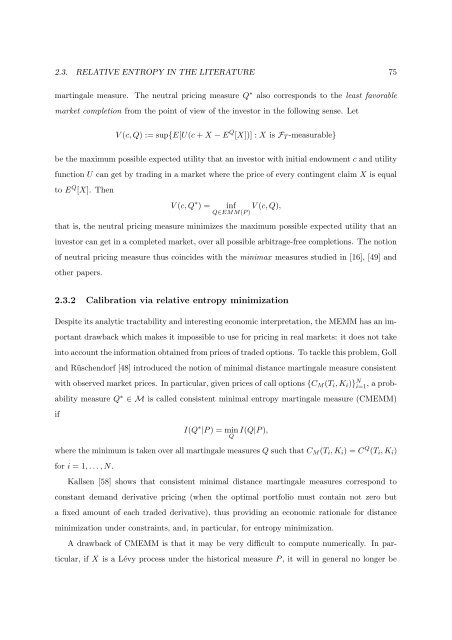Processus de Lévy en Finance - Laboratoire de Probabilités et ...
Processus de Lévy en Finance - Laboratoire de Probabilités et ...
Processus de Lévy en Finance - Laboratoire de Probabilités et ...
You also want an ePaper? Increase the reach of your titles
YUMPU automatically turns print PDFs into web optimized ePapers that Google loves.
2.3. RELATIVE ENTROPY IN THE LITERATURE 75<br />
martingale measure. The neutral pricing measure Q ∗ also corresponds to the least favorable<br />
mark<strong>et</strong> compl<strong>et</strong>ion from the point of view of the investor in the following s<strong>en</strong>se. L<strong>et</strong><br />
V (c, Q) := sup{E[U(c + X − E Q [X])] : X is F T -measurable}<br />
be the maximum possible expected utility that an investor with initial <strong>en</strong>dowm<strong>en</strong>t c and utility<br />
function U can g<strong>et</strong> by trading in a mark<strong>et</strong> where the price of every conting<strong>en</strong>t claim X is equal<br />
to E Q [X]. Th<strong>en</strong><br />
V (c, Q ∗ ) =<br />
inf V (c, Q),<br />
Q∈EMM(P )<br />
that is, the neutral pricing measure minimizes the maximum possible expected utility that an<br />
investor can g<strong>et</strong> in a compl<strong>et</strong>ed mark<strong>et</strong>, over all possible arbitrage-free compl<strong>et</strong>ions. The notion<br />
of neutral pricing measure thus coinci<strong>de</strong>s with the minimax measures studied in [16], [49] and<br />
other papers.<br />
2.3.2 Calibration via relative <strong>en</strong>tropy minimization<br />
Despite its analytic tractability and interesting economic interpr<strong>et</strong>ation, the MEMM has an important<br />
drawback which makes it impossible to use for pricing in real mark<strong>et</strong>s: it does not take<br />
into account the information obtained from prices of tra<strong>de</strong>d options. To tackle this problem, Goll<br />
and Rüsch<strong>en</strong>dorf [48] introduced the notion of minimal distance martingale measure consist<strong>en</strong>t<br />
with observed mark<strong>et</strong> prices. In particular, giv<strong>en</strong> prices of call options {C M (T i , K i )} N i=1 , a probability<br />
measure Q ∗ ∈ M is called consist<strong>en</strong>t minimal <strong>en</strong>tropy martingale measure (CMEMM)<br />
if<br />
I(Q ∗ |P ) = min I(Q|P ),<br />
Q<br />
where the minimum is tak<strong>en</strong> over all martingale measures Q such that C M (T i , K i ) = C Q (T i , K i )<br />
for i = 1, . . . , N.<br />
Kalls<strong>en</strong> [58] shows that consist<strong>en</strong>t minimal distance martingale measures correspond to<br />
constant <strong>de</strong>mand <strong>de</strong>rivative pricing (wh<strong>en</strong> the optimal portfolio must contain not zero but<br />
a fixed amount of each tra<strong>de</strong>d <strong>de</strong>rivative), thus providing an economic rationale for distance<br />
minimization un<strong>de</strong>r constraints, and, in particular, for <strong>en</strong>tropy minimization.<br />
A drawback of CMEMM is that it may be very difficult to compute numerically. In particular,<br />
if X is a Lévy process un<strong>de</strong>r the historical measure P , it will in g<strong>en</strong>eral no longer be
















